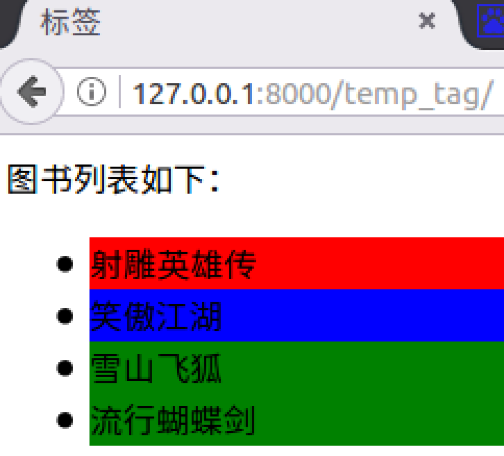标签
语法如下:
{%代码段%}
for标签语法如下:
{%for item in 列表%}
循环逻辑
{{forloop.counter}}表示当前是第几次循环,从1开始
{%empty%}
列表为空或不存在时执行此逻辑
{%endfor%}
if标签语法如下:
{%if ...%}
逻辑1
{%elif ...%}
逻辑2
{%else%}
逻辑3
{%endif%}
比较运算符如下:
注意:运算符左右两侧不能紧挨变量或常量,必须有空格。
==
!=
<
>
<=
>=
布尔运算符如下:
and
or
not
点击查看内建标签了解更多标签,还有一些常用的标签会在后续地章节中讲解。
示例
1)打开booktest/views.py文件,创建视图temp_tag。
from booktest.models import BookInfo
def temp_tags(request):
context={'list':BookInfo.objects.all()}
return render(request,'booktest/temp_tag.html',context)
2)打开booktest/urls.py文件,配置url。
url(r'^temp_tag/$', views.temp_tags),
3)在templates/booktest下创建temp_tag.html。
<html>
<head>
<title>标签</title>
</head>
<body>
图书列表如下:
<ul>
{%for book in list%}
{%if book.id <= 2%}
<li style="background-color: red;">{{book.btitle}}</li>
{%elif book.id <= 3%}
<li style="background-color: blue;">{{book.btitle}}</li>
{%else%}
<li style="background-color: green;">{{book.btitle}}</li>
{%endif%}
{%empty%}
<li>对不起,没有图书</li>
{%endfor%}
</ul>
</body>
</html>
4)运行服务器,在浏览器中输入如下网址。
http://127.0.0.1:8000/temp_tag/
浏览效果如下图:
